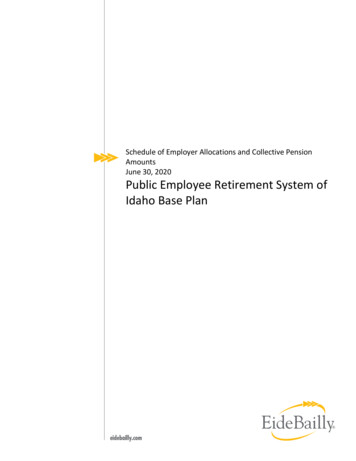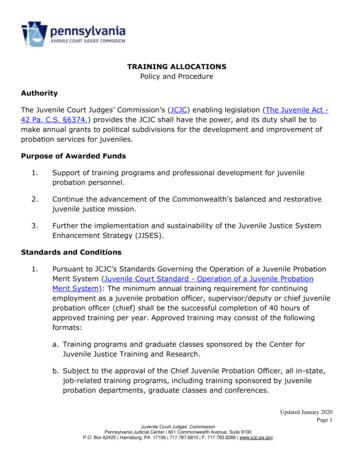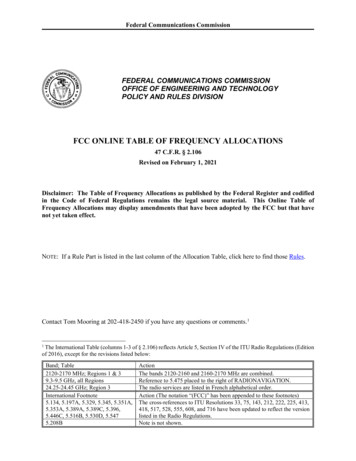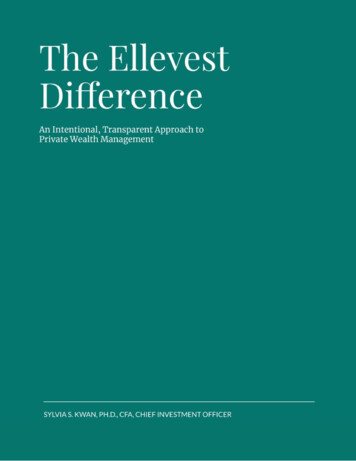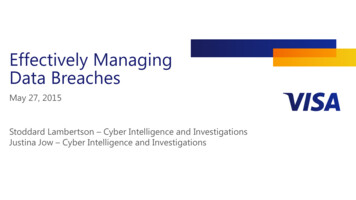
Transcription
Managing allocations effectivelyin the insurance sector
Managing allocations effectively in the insurance sectorExecutive summaryFor organizations toimprove profitabilityand accountability, it iscritical that all productsand services receivetheir appropriateshare of revenue andcost allocations andthat organizationsunderstand the “cost toserve” their customers.In today’s world of bundled pricing, centers of excellence, and shared services,organizations must actively manage profitability and accountability acrossproducts, customers, regions, and channels—driving the need for structuredand sometimes complex allocations. For organizations to improve profitabilityand accountability, it is critical that all products and services receive theirappropriate share of revenue and cost allocations and that organizationsunderstand the “cost to serve” their customers.Finance organizations seek to provide comprehensive, credible, andactionable information about their expenses. For companies leveraging avariety of business units, shared services, and locations to offer multipleproducts, meeting such objectives is more challenging, given the high levelof indirect costs to allocate in the insurance sector. Cost allocation poolsand dynamic drivers are developed to face this challenge but are onerousto manage and explain. Furthermore, the allocation process becomes anexercise of making contra entries across the organization, rather than aninitiative to manage and reduce costs.In this current unique period, the convergence of aging legacy platforms,complex market dynamics, and a mature vendor landscape has madetransformation a top priority. We expect core system transformations relatedto compliance and profitability management (including allocations) to continueto be a top priority for insurers in the future.This paper defines challenges and best practices for expense allocations inthe insurance sector.2
Managing allocations effectively in the insurance sectorChallenges for theinsurance industryA highly intermediated distribution model, as well ashigh regulatory granularity and transparency, driveinsurers to develop complex cost allocation models.In the insurance industry, cost allocations arecritical due to two trends. First, tighteningmargins and increased competition heightenthe need to scrutinize expenses; second,insurers’ highly intermediated distributionmodels and regulator requirements forgranularity and transparency drive insurersto develop complex cost allocation models.Due to these factors, steering businessmargins in the insurance industry is moreimportant than ever.While insurance demand is on the positiveside, margins are moving the other way. Theproperty and casualty (P&C) sector faces highlosses related to natural disasters and moreexpensive automobile claims. The life sectoris struggling to enable consistently positivefinancial results due to low fixed-incomeyields over several years.On the supply side, behavioral evolutionand “insurtech” push for enhanced userexperiences and the use of analytics. Theseimpose a required level of investment forinnovation, transformation, and technology.The following factors push insurance costallocation models toward high complexity: Complex business model: Insurers’business development relies on a mix ofdirect distribution and intermediationthrough brokers, partners, and reinsurers,each bringing different cost structures.For the business to obtain a full pictureof profitability, distribution channel andreinsurance information need to beintegrated into allocation models. Theseviews add to standard cost hierarchies,including nature of the cost (acquisition vs.3
Managing allocations effectively in the insurance sectorrenewal), geography, business unit, legalentity, and product. Additionally, insurersmay allocate to activity, process, andservice to enable profitability analysis. Role of regulators: The insurer’s role inthe overall financial system has consistentlyled insurance regulators to be among themost demanding. Moreover, insurancecompanies trading under differentjurisdictions face multiple regulations,namely state, national (long-durationtargeted improvements [LDTI]), regional(Solvency II), and global (InternationalFinancial Reporting Standards 17[IFRS 17]). Requirements on expensereporting include the presentation of fullyallocated expenses across numerous linesof business and accounting destinations.The portion attributable to contracts anddeferred acquisition costs also needs tobe distinguished. All of these dimensionsneed to be provided with granularity andtraceability that satisfies both regulatorsand auditors. Reliance on high-technology spend:Insurance companies need advancedtechnology to obtain insights on the highvolume of business and actuarial data.This, combined with the volumes of datarequired by regulatory requirements,makes technology costs one of themajor expenses affecting profitability.Insurance leaders overwhelmingly considerinformation technology as the greatest costand expense management challenge—faroutpacing the challenge of regulatory andaccounting compliance.These complexities lead to difficulty and alack of transparency for reporting end userstrying to understand the origins and driversof costs.In their efforts to standardize and ensurea fair representation of the impacts ofinsurance contracts, both IFRS 17 and LDTI to4US GAAP translate into requiring additionaldetails and transparency of expenses. Thisincludes grouping and presenting insurancecontracts withsimilar risks.Additionally, new standards requirecompanies to project future cash flowsfor the whole duration of contracts. Animportant component of cash flow andfulfilling contracts is attributing expenses;therefore, continuous energy must bededicated to defining the right amountof attributable overhead costs andexpense recharges to present the mostadvantageous projections on financials.Granularity, transparency, and “what if?”analysis capabilities will help organizationsface these challenges.Both IFRS 17 andLDTI translate intorequiring additionaldetails andtransparencyof expenses.
Managing allocations effectively in the insurance sectorDistinctive businesschallenges forinsurance subsectorsEach insurance subsector faces unique costmanagement and allocations challenges.Variances across insurance subsectors aremainly driven by corresponding product lifecycles and transaction volumes.P&C companiesP&C insurance market trends driveincreased scrutiny on cost efficiency. Asdemand for insurance products increases,profitability may decrease due to increasingcosts and losses. In the coming years,premiums are expected to rise due topopulation and commercial businessgrowth (especially middle-market and largeaccounts). In turn, demand for propertyinsurance (due to expected increases innatural disasters), automobile insurance,and specialty insurance will grow. However,loss levels are also expected to increase dueto distracted driving and costly damage fromnatural disasters.The focus on cost efficiency is even morecritical when considering the need forP&C companies to invest in digitization todevelop usage-based coverage models,as well as customer experience focuseduser interfaces.Other P&C characteristics that makeexpense reporting complex include highvolumes of transactions, shorter contractdurations, and fewer specific workflows,such as subrogation. Part of P&C’s costmanagement objective is to highlight therelationship between marketing expensesand policy renewals and to illustrate thecosts supporting efficient customer-centricpolicy acquisition and claims managementprocesses. Additionally, for P&C commerciallines, expense and cost allocations can bechallenging due to how they change yearover-year, given the nature of the business.Life and annuities (L&A) companiesDespite a significant increase expectedin sales of L&A products, the subsectoris focused on profitability improvementdue to low interest rates and the relativelyhigh-level cost of intermediation (bothon the production and the distributionend). Additionally, the need to invest inproduct simplification and streamlining thepolicyholder application process hasmade increased cost transparencyextremely important.L&A cost allocation models typicallyrequire detailed metrics on acquisitioncosts, financial management costs, andcommissions. Management also evaluatesmetrics such as customer experiencescores to prevent early terminations—akey aspect that erodes an L&A company’sprofitability levels.ReinsurersReinsurers interact with the cost structuresof their insurance markets, as well asmanage their own costs internally. Inaddition, their business model relies onprofitability assumptions often associatedwith strict cost-ratio targets, enhancing theneed for efficient cost models.A reinsurer's cost base can be affected bytalent policies targeting top-tier actuarialskills in attractive locations, resulting in highsalary and housing costs.Information technology is also an importantexpense. Driven by high volumes of datafound in treaties and contracts, reinsurersrequire customized computation andanalytics to derive the required insight fromtheir data.Composite companiesComposite companies combining L&A, P&C,and/or reinsurance businesses must not onlyaggregate all their business specificities, butalso design a universal cost model that canbe applied to heterogeneous components.Composite organizations typically comewith more organizational complexity and agreater need for coordination from corporatefunctions, the use of shared services orcenters of excellence, and operationsacross multiple countries and jurisdictions.These operating models not only lead tohigher levels of indirect costs—for whicha consensus on allocation drivers must befound across businesses—but also need tocomply with multiple regulatory reportingrequirements. As each business increasesits consideration of the various requiredmanagement-reporting dimensions, thepotential complexity of the cost allocationmodel also significantly increases.5
Managing allocations effectively in the insurance sectorAllocations:Self-inflicted complexityThere is no transparency in the process—who isallocating to whom, and how, is a mystery for thevarious customers of the cost allocation.In a finance team’s efforts to developbusiness insights and comply withregulators, one common pitfall is to proposecost allocation models that are extremelycomplex and lack transparency. Mostcompanies experience similar issues—thetime to run allocations is long and theallocation preparation work requires asignificant amount of time to coordinatebecause it involves reaching across theorganization for rates and rules. There isno transparency in the process—who isallocating to whom, and how, is a mysteryfor various customers of cost allocations.Allocation solutions are the ultimate “blackbox” in most organizations. One of the keyconsequences of this is the business’s lackof ownership over expenses, drasticallyreducing its ability to manage costs. Significant debate on the results:Significant time is spent debating theoutput regarding accuracy of the allocatedamount, allocation driver, and/or amountof the chargeback.Several challenges are faced when tryingto transform cost allocation models forinsurance companies: Lack of governance processes: Lackof governance results in unstructuredhierarchies and unstructured drivers forallocation of costs. Lengthy execution time: Time torun the allocation process is long andrequires a significant amount of effortand coordination. Lack of transparency and traceability:Process is viewed as a “black box” withno drill-back capability from the allocatedamount to the allocation driver. Allocationprocesses are based on unstructured datahierarchies and rules that only providelimited transparency.6 Lack of reporting and decisionsupport: Post-allocated reports are at alevel higher than the business requires,limiting the ability to conduct analytics. Complexity and lack of propersystems: Existing systems are old,inefficient, and have data-volumelimitations that significantly disrupt theallocation process. Lack of focus on cost management:Focus is more on making contra entriesacross the organization rather than aninitiative to manage and reduce costs.Examples of how allocation model complexityis related to organizational practices areas follows: Unstructured hierarchies and datamodel: In an attempt to simplify theprocess of allocations (in the shortrun), cost centers and products arerepresented as financial accounts inallocation technology solutions. While thismay simplify the process of allocations, itcomplicates governance and maintenancein the long run. This makes governinghierarchies more difficult in the future, asmembers created strictly for the allocationprocess do not fit into the formal definitionof the hierarchy. Precision is confused with accuracy:Emphasis is more on creating businessrules to allocate dollars down to thelast penny, with little emphasis onunderstanding the appropriate costpools and cost drivers. Heavy use of spreadsheets:Spreadsheets are a powerful tool; however,when used for allocations, they createprecisely the wrong results and lead to alack of transparency. Most of the allocationrules are created dynamically on a monthto-month basis, which unfortunatelyproduces a strong temptation to usespreadsheets to create cost pools, drivers,and resulting allocations. Lack of ability to capture direct costsappropriately: Most accounting andcosting systems cannot capture anddirectly align costs to the necessaryproduct, state, or distribution channel attime of booking. The inability to directlyalign costs means all costs must gothrough the allocation process. Thisadds an additional step to the allocationprocess, making it less efficient.
Managing allocations effectively in the insurance sectorSolution perspectiveAllocation frameworkThe allocation framework, including costpools and drivers, must be developedholistically with organizational consensus andan appropriate governance model. Whenfirms approach the allocation process, theyshould consider the following framework: Philosophy: The goals of the processmust align with business objectives andcorporate structure. Management andreduction of costs must be key objectivesfor the organization. Methodology: The cost methods, pools,and level of granularity utilized to drivethe overall process. Consistency andgovernance must be more importantthan trying to achieve precision forcost allocations. Drivers: The various statistics andmetrics used to push down expensesto various parts of the business mustbe clearly defined and obtained in astreamlined manner.responsibilities should be clearly defined,documented, and understood by allparticipants in the process.Allocation leading practicesLeading allocation practices aim to linkallocated costs to business drivers thatare controllable and therefore actionableby the business. Design with the end in mind: Beforeredesigning the allocation methodology, itis crucial to understand the level of profitand loss (P&L) and expense reportingthat a company’s decision makers need.It should enable them to make actionabledecisions in a timely manner. Additionally,recent technology advancements havemade it possible to convert data intoactionable insights in unprecedentedways, and this must be considered whiledesigning the target solution. Systems and tools: The tools andtechnologies used to facilitate andoperationalize the allocation processmust be scalable and efficient. Reporting: The ongoing reports todetail on costs and create allocationtransparency across the organization.The reports and the output of theframework must facilitate decision supportfor better decision making versus purelyreporting on the allocation of costs. Roles and responsibilities: Theownership of various elements within theprocess, including governance, modelmanagement, and interactions betweencorporate and business units. Roles and Lay the foundation: As a first step inoverhauling the process, companies muststart with the foundation—the hierarchies,structures, and code block elementsthat make up the process. They mustevaluate where costs are booked andwhere they are allocated and develop acomplete definition that should describeevery member in the hierarchy. One ofthe key elements of this exercise is therationalization of the cost center hierarchyto ensure that unnecessary elements(such as temporary cost centers thatare not required anymore) do not burdenthe future-state process. Also, this isthe step where organizations shouldensure that all direct costs are beingcaptured outside the cost pools for directattribution of costs to products, markets,and customers.PhilosophyRoles and ngSystems and tools7
Managing allocations effectively in the insurance sector Involve cost center owners andstakeholders early and often.The allocation process includesstakeholders from across the organization,such as cost center owners, productowners, lines of business executives, andactuaries involved in deferred acquisitioncosts (DAC), and pricing. While the guidingprinciples and methodology design canbe centrally developed, the project willnot succeed if stakeholders from acrossthe organization are not involved in theprocess from day one. Just because you can do it, does notmean you should. Throughout the designprocess, the stakeholders will inevitablyask if they can create a complicatedmethodology in the new solution. Whilenew technology can handle more complexrules than what is enabled in organizationsin the current state, that does not meanthat organizations should do so. Theproject team must stop and ask, “Will thenew method be any more accurate?” Data visualization tools help makethe process more transparent.Even the best redesigned allocationprocesses produce a significant amountof data. When reporting processesare evaluated, organizations shouldinvestigate data visualization tools such asTableau or Qlik to help them understandtheir post-allocated results by turningraw data into actionable insights. Building8a visual allocation trace map that allowsusers to step through the allocationprocess, from the result to the initialdriver of the expense, is a powerful valueproposition for understanding postallocation results.rules and rates are updated and costcenters and expense accounts are addedshould be a key output of the project. Thegovernance process should be viewed asa companywide effort—not one that isowned by corporate only. Run as many simulations as possible,understand where the breakage is,and communicate accordingly.Redefining the allocation methodologywill likely result in post-allocated amountdifferences from the allocation results inthe current state. Organizations shouldexpect and plan for this. Going livewith a new process for the plan insteadof the actuals helps in accounting forthe breakage. Additionally, conductingsimulations of the new allocation methodon a historically pre-allocated data set,then comparing results between old andnew post-allocated data, will be extremelyimportant for reporting purposes. Thoseresults should also be shared withstakeholders across the organization sothey are aware and understand wherebreakage will exist in the new process. Transparency is not the desiredend state. While transparency into theallocation process will realize specific wins,it should not be the desired end state.Rather, transparency should be viewed asa mechanism to achieve more effectiveconversations between the “buyers” and“suppliers” in the organization. Governance, governance, governance.When designing a new allocation solution,companies should account for the methodthat they will use to maintain the processand solution. Companies that do notdesign governance processes run therisk of reverting back to old processes.Defining a process by which allocation Trying to build and launch a newallocation solution for the entireorganization all at once is not alwaysthe right answer. An effective approachmay be to choose a specific business issue,preferably one that will yield significantvalue once addressed. Next, use theprototype as a pilot to receive buy-in fromkey stakeholders for a broader rollout.
Managing allocations effectively in the insurance sectorTechnology optionsPerforming cost allocations in the insurancesector and financial solutions support basicallocation features. However only somesolutions are purpose-built for allocationsand enable the design of advanced modelswith a high level of flexibility, traceability,and performance for the required volumes,complexity, and level of details observed inthe insurance sector. Figure 2 notes the mostcommonly considered solutions to supportcost allocation models.Figure 2.ProductHigh-level descriptionAnaplan forFinanceAnaplan is a platform powered by proprietary HyperBlock technology. The cloud-based solution provides acustomizable modeling engine to support a variety of modeling needs, including purpose-built applications foractivity-based costing, expense allocations, etc.Profitability and Cost Oracle PCMCS is a performance management application that is part of Oracle’s enterprise performanceManagement Cloudmanagement system and helps to manage the cost and revenue allocation necessary to compute profitability byService (PCMCS)business parameters such as product, customer, and region.SAP Profitabilityand PerformanceManagementSAP Profitability and Performance Management (PaPM) is an SAP HANA-based solution to develop and executecomplex allocation models to support enhanced costing and profitability analysis. The tool also supports the modelsfor intercompany price-setting, driver-based planning, risk, capital and solvency calculations, etc.SAS Cost andProfitabilityManagementSAS Cost and Profitability Management is an analytic application that determines cost and profitability by modelingbusiness processes as cost flows among accounts. With this solution, organizations can make informed decisionsthat streamline processes, deliver revenue growth, and reduce costs across the organization.9
Managing allocations effectively in the insurance sectorKey takeawaysThe complexity in expense allocations for the insurance industry is expectedto increase, given the importance of indirect costs, the diversity of insuranceproducts, the high level of intermediation in the distribution process, and theregulatory push for granularity and transparency.These imposed constraints enhance the need for a “design-thought” approach,ensuring that allocation models deliver visual and transparent insights to theircustomers with standardized, structured, and technology-enabled processes anddata management.The time to get started is today!Having timely, relevant, and actionable information about cost and profitabilityis a cornerstone for more effective decision-making. Insurance companiesshould take a fresh look at their allocations processes and systems through adedicated assessment project and evaluate if updated capabilities and practiceswould be right for them. In today’s insurance industry, managing allocationseffectively and efficiently is no longer simply a “nice-to-have” capability—it’sessential for survival.10
Managing allocations effectively in the insurance sectorContactsRaj ChhabraManaging DirectorDeloitte Consulting LLPrchhabra@deloitte.com 1 313 396 5919Gina VargasSenior ManagerDeloitte Consulting LLPgvargas@deloitte.com 1 212 313 1725Pardeep SharmaSpecialist LeaderDeloitte Consulting LLPpardsharma@deloitte.com 1 704 887 197311
About DeloitteDeloitte refers to one or more of Deloitte Touche Tohmatsu Limited, a UKprivate company limited by guarantee (“DTTL”), its network of member firms,and their related entities. DTTL and each of its member firms are legallyseparate and independent entities. DTTL (also referred to as “Deloitte Global”)does not provide services to clients. In the United States, Deloitte refers to oneor more of the US member firms of DTTL, their related entities that operateusing the “Deloitte” name in the United States, and their respective affiliates.Certain services may not be available to attest clients under the rules andregulations of public accounting. Please see www.deloitte.com/about to learnmore about our global network of member firms.This publication contains general information only and Deloitte is not, by meansof this publication, rendering accounting, business, financial, investment, legal,tax, or other professional advice or services. This publication is not a substitutefor such professional advice or services, nor should it be used as a basis for anydecision or action that may affect your business. Before making any decision ortaking any action that may affect your business, you should consult a qualifiedprofessional adviser.Deloitte shall not be responsible for any loss sustained by any person who relieson this publication. 2020 Deloitte Development LLC. All rights reserved.
Managing allocations effectively in the insurance sector 5 Each insurance subsector faces unique cost management and allocations challenges. Variances across insurance subsectors are mainly driven by corresponding product life cycles and transaction volumes. P&C companies P&C insurance market trends drive increased scrutiny on cost efficiency. As





